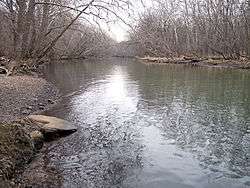Sandy Creek (Ohio)
Sandy Creek is a tributary of the Tuscarawas River, 41.3 miles (66.5 km) long, in northeastern Ohio in the United States. Via the Tuscarawas, Muskingum and Ohio Rivers, it is part of the watershed of the Mississippi River, draining an area of 503 square miles (1,303 km²).
| Sandy Creek | |
|---|---|
 Sandy Creek near its mouth, downstream of Bolivar Dam in 2006 | |
 Location of the mouth of Sandy Creek | |
| Location | |
| Country | United States |
| State | Ohio |
| Physical characteristics | |
| Source | |
| • location | Hanover Township, Columbiana County |
| • coordinates | 40°46′19″N 80°54′09″W[1] |
| • elevation | 1,299 ft (396 m)[2] |
| Mouth | Tuscarawas River |
• location | Bethlehem Township, Stark County |
• coordinates | 40°39′28″N 81°26′14″W[1] |
• elevation | 887 ft (270 m)[2] |
| Length | 41.3 mi (66.5 km)[2] |
| Basin size | 504 sq mi (1,310 km2)[2] |
| Discharge | |
| • location | Waynesburg[3] |
| • average | 278 cu ft/s (7.9 m3/s) |
| • minimum | 6.9 cu ft/s (0.20 m3/s) |
| • maximum | 15,000 cu ft/s (420 m3/s) |
| Basin features | |
| Tributaries | |
| • left | Still Fork |
| • right | Nimishillen Creek |
Sandy Creek rises in Hanover Township, approximately two miles (3 km) northeast of Hanoverton in western Columbiana County and flows generally west-southwestwardly through northwestern Carroll County, southeastern Stark County and northeastern Tuscarawas County, past the communities of Kensington, Minerva, Malvern, Waynesburg and Magnolia. It joins the Tuscarawas River from the east in Bethlehem Township in Stark County, approximately one mile (2 km) northeast of Bolivar. At Minerva, it collects the Still Fork. At Waynesburg it collects a short stream known as Little Sandy Creek.[4] In Sandyville, Tuscarawas County it collects Nimishillen Creek, which drains the city of Canton.[5]
A dry dam, Bolivar Dam, constructed by the U.S. Army Corps of Engineers, spans the creek near its mouth.[5][6]
Flow rate
At the United States Geological Survey's stream gauge in Waynesburg,[7] the annual mean flow of the river between 1939 and 2005 was 278 ft³/s (8 m³/s). The highest recorded flow during the period was 15,000 ft³/s (425 m³/s) on January 22, 1959. The lowest recorded flow was 6.9 ft³/s (0 m³/s) on an unspecified date.[3]
Variant names
According to the Geographic Names Information System, Sandy Creek has also been known historically as:[1]
- Big Sandy Creek
- Big Sandy River
- Elks Eye Creek
- Lamanshicolas Creek
- Lamenshikola Creek
See also
References
- Geographic Names Information System. "GNIS entry for Sandy Creek (Feature ID #1066944)". Retrieved 2007-01-12.
- Ohio Department of Natural Resources. "GAZETTEER_OF_OHIO_STREAMS" (PDF). Retrieved 2010-01-07.
- Mangus, J. P.; S. R. Frum. "USGS Ohio Water Resources Data, Water Year 2005". United States Geological Survey. pp. Surface-water records, Surface-water records, Beaver through Muskingum River Basins (p. 41–77). Retrieved 2007-05-21.
- "Geographic Names Information System entry for Little Sandy Creek". Retrieved 2007-01-12.
- Ohio Atlas & Gazetteer. Yarmouth, Me.: DeLorme. 1991. pp. 51–53. ISBN 0-89933-233-1.
- United States Army Corps of Engineers. "Bolivar Dam". Archived from the original on 2007-02-06. Retrieved 2007-01-12.CS1 maint: BOT: original-url status unknown (link)
- real time flow information